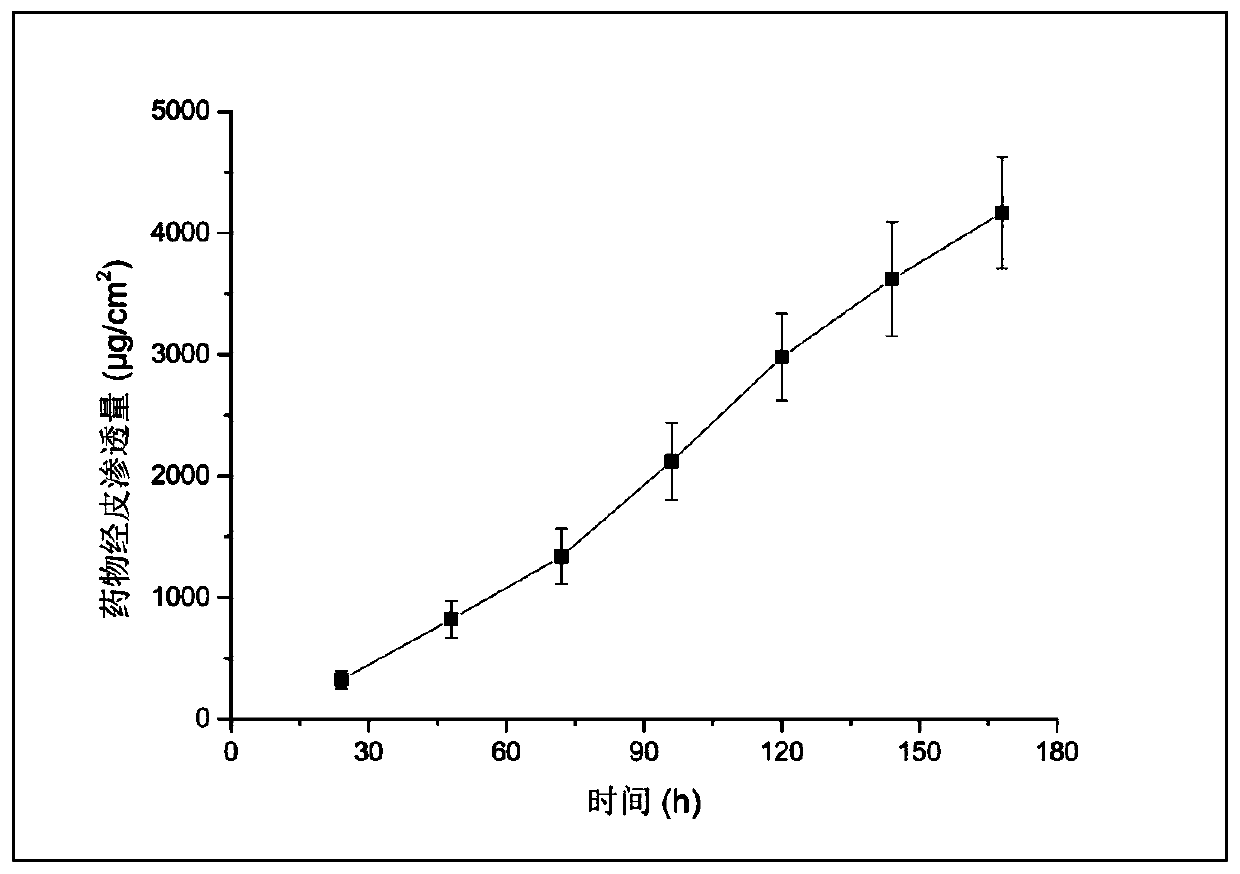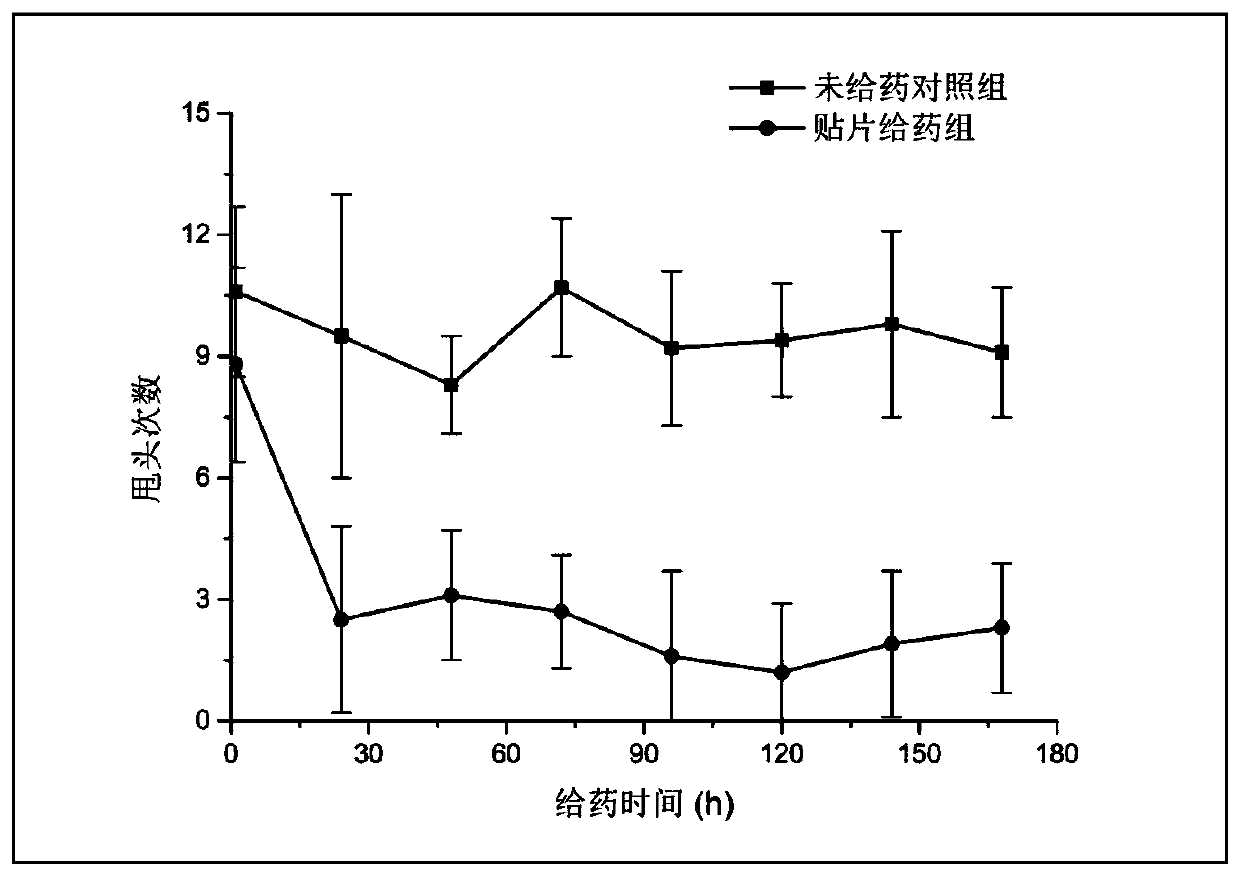Percutaneous sustained-release patch for resisting schizophrenia
A technology of schizophrenia and slow-release patches, which is applied to nervous system diseases, medical preparations containing no active ingredients, medical preparations containing active ingredients, etc., can solve problems such as poor compliance, achieve blood drug concentration stability, Good penetration promoting effect and good dissolution effect
- Summary
- Abstract
- Description
- Claims
- Application Information
AI Technical Summary
Problems solved by technology
Method used
Image
Examples
Embodiment 1
[0040] Prescription (100g feeding):
[0041]
[0042] Add the prescribed amount of aripiprazole to ethyl oleate, Span-20 and menthol to dissolve, add 1,2-propylene glycol under high-speed homogeneous stirring, then add polyacrylate and polyisobutylene respectively, and stir evenly. Finally, hydroxypropyl-β-cyclodextrin and anhydrous sodium sulfite were added and stirred evenly, and the bubbles were removed by ultrasonic waves and left to stand until the bubbles completely disappeared to obtain a pressure-sensitive adhesive reservoir layer. Coat the pressure-sensitive adhesive reservoir layer on the release layer, dry at 80°C for 45 minutes, and cut the backing layer covering the surface of the pressure-sensitive adhesive reservoir layer into 50cm 2 Patch, prepared aripiprazole transdermal slow-release patch.
[0043] The aripiprazole sustained-release transdermal patch has passed the human isolated skin penetration test in a Valia-Chien osmotic cell, and the receiving solu...
Embodiment 2
[0045] Prescription (total 100g):
[0046]
[0047] Add the prescribed amount of aripiprazole to linoleic acid monoglyceride, Span 20 and laurocaprazine to dissolve, add 1,2-propanediol under high-speed homogeneous stirring, and then add polyacrylate and polyisobutylene respectively, Stir evenly, and finally add chitosan and dibutylphenol, stir evenly, remove bubbles by ultrasonic waves and let the bubbles disappear completely, so as to obtain a pressure-sensitive adhesive storage layer. Coat the pressure-sensitive adhesive reservoir layer on the release layer, dry at 80°C for 45 minutes, and cut the backing layer covering the surface of the pressure-sensitive adhesive reservoir layer into 50cm 2 Patch, prepared aripiprazole transdermal slow-release patch.
[0048] The aripiprazole sustained-release transdermal patch has passed the human isolated skin penetration test in a Valia-Chien osmotic cell, and the receiving solution is 40% polyethylene glycol normal saline. Such ...
Embodiment 3
[0050] Prescription (total 100g):
[0051]
[0052] Add the prescribed amount of aripiprazole into monoglyceride, lauric caprylic acid monoglyceride, diethylene glycol monoethyl ether to dissolve, add 1,2-propanediol under high-speed homogeneous stirring, and then add polyacrylate, poly Isoprene, stirred evenly, finally added hydroxypropyl-β-cyclodextrin, anhydrous sodium sulfite, stirred evenly, ultrasonically removed the bubbles and left to stand still, the bubbles completely disappeared, and the pressure-sensitive adhesive reservoir layer was obtained. Coat the pressure-sensitive adhesive reservoir layer on the release layer, dry at 80°C for 45 minutes, and cut the backing layer covering the surface of the pressure-sensitive adhesive reservoir layer into 50cm 2 Patch, prepared aripiprazole transdermal slow-release patch.
[0053] The aripiprazole sustained-release transdermal patch has passed the human isolated skin penetration test in a Valia-Chien osmotic cell, and th...
PUM
 Login to View More
Login to View More Abstract
Description
Claims
Application Information
 Login to View More
Login to View More - R&D
- Intellectual Property
- Life Sciences
- Materials
- Tech Scout
- Unparalleled Data Quality
- Higher Quality Content
- 60% Fewer Hallucinations
Browse by: Latest US Patents, China's latest patents, Technical Efficacy Thesaurus, Application Domain, Technology Topic, Popular Technical Reports.
© 2025 PatSnap. All rights reserved.Legal|Privacy policy|Modern Slavery Act Transparency Statement|Sitemap|About US| Contact US: help@patsnap.com



